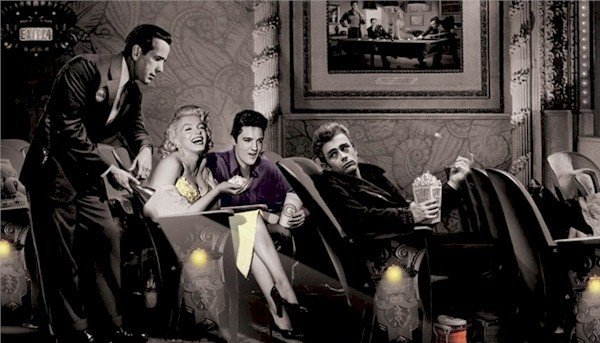In the world of advertising and licensing, these are great days to be a dead celebrity. Brands are reimagining beloved pop culture icons from previous eras as stars of today’s ads.
Icons like Marilyn Monroe, Frank Sinatra and Audrey Hepburn are ubiquitous — with their images, old movie clips and voices being deployed by creatives to emote an image and quality that moves mega-units for brands. Today, the marketing, licensing and commercial use of dead celebrities is an estimated $3.0 billion business.
Most successful campaigns use celebrities who were recognized as experts or are closely associated with the products advertised, those that tap into a celebrity’s (or deceased celebrity’s) niche appeal, and are familiar to the target audience. It’s about selling a message first, product second and it boils down to perceived expertise, trustworthiness and attractiveness. Keep in mind tastes vary by territory in which ads are activated – what Audrey Hepburn can do for McDonald’s in the UK may not translate in the US.
Today, the monetization of publicity rights of deceased celebrities has markedly expanded as new technology, such as holograms and computer-generated imagery can keep the virtual celebrity alive and entertaining us forever.
Take for example, the Audrey Hepburn Dove/Galaxy Chocolate ad. According to PR Newswire, “the visual effects team at Framestore…used the star’s entire film catalog and all available photographs as reference.” Framestore explains in creating the ad the process started with an exhaustive search for the perfect Audrey Hepburn double. The hope was to find someone who could give [director Daniel] Kleinman the performance that he needed, and ideally to share as many of her features and characteristics as possible. Framestore then completed a round of extensive pre-shoot facial scanning at its in-house Capture Lab in order to deliver the complexities demanded by this project. This included a FACS (facial action coding system) session that allowed the team to record more than 70 possible muscle movements and capture high resolution textures for building their CG Audrey. After the shoot, Framestore set about building a facial rig using the FACS head scans as reference for the multitude of shapes the human face can achieve. The 3D team built the model of Hepburn, making use of the star’s entire feature film catalogue, plus all available press and documentary photographs as reference. So “the model” is the CGI’d Hepburn, and “the actress” is the Hepburn double. They scrapbooked the old footage and pictures onto the actress’s face, which created the model.
Despite the fact that a dead celebrity now poses little risk of embarrassment or a PR nightmare, it is worth noting that dealing with the estates of dead celebrities who are not in the public domain, and the parties related to their image such as photographers who own the copyrights, as well as movie studios and music licensed holders, agents etc can be complex to say the least. Addressing all the layers of rights needed to be vetted for use and licensed can be like eating a clock – very time consuming. It all can be worth it in the end and in some instances charitable! Some deceased celebrity’s with protected rights may have willed any profit generated by their estate to charity.
Meet The Licensing Superstars
So who is an example of being a top earner post mortem, and what are some of the lessons learned? The right of Publicity is the right of a person to control the commercial exploitation of his/her identity, and prevent unauthorized commercial use, and is governed by state law. Personality rights are generally considered to consist of two types of rights: the right of publicity, or to keep one’s image and likeness from being commercially exploited without permission or contractual compensation, which is similar to the use of a trademark; and the right to privacy, or the right to be left alone and not have one’s personality represented publicly without permission.
Forbes now has an entire website devoted to “top-earning dead celebrities.” More than a few notable celebrities are monetarily worth more dead than alive. Coming in at No. 1 on the Forbes top-earning dead celebrities list is the “King of Pop,” Michael Jackson. Since Jackson’s death in 2009, the estate has generated more than a whopping $1 billion in revenue by licensing his name, likeness and music—including the Las Vegas Cirque du Soleil show “Michael Jackson: One,” the Mijac Music catalog, music sales and half of the Sony/ATV publishing empire according to Forbes. It seems the “King of Pop’s” estate knew all too well the grim truth about an artist’s economic value and perhaps explains why, a mere two months after Mr. Jackson passed away in 2009, his estate filed a number of applications for federal trademark registrations in the late singer’s name. The Lanham Act does not preclude such posthumous registration protection provided that the applications are filed by the late celebrity’s estate or heir(s). If someone other than the owner of the celebrity’s post mortem rights attempts to register the celebrity’s name or image as a trademark, they should be barred from doing so under Section 2(a).
But popular celebrities who wish to protect their branding rights in perpetuity take heed — be certain to bequeath these rights of publicity as part of your legacy. In addition, as with Robin Williams, if you do not wish to make millions beyond the grave, one may create a licensing prevention clause when planning one’s estate.
Heirs and estates of dead celebrities argue that celebrities should be able to leave their “assets” to their heirs, and that it would be unfair to allow an advertiser or a merchandiser to make money without sharing it with the celebrity’s family. Advertisers, merchandisers, and public domain advocates argue that celebrities shouldn’t be able to control how their images are used after death. So, what is a deceased celebrity (delebrity) worth? First, note that there are tangible assets – cars, bank accounts, homes; and intangible assets – copyrights, trademarks [and] the right of publicity, which is the right to your name and likeness.
Protected Intangible Assets
What’s key here are the celebrity’s intangible assets that are protected and passed on, the state in which said celebrity was a resident and to which the deceased rights of publicity laws pertain.
As experts in valuing intangible assets for estate planning, oftentimes we find that there can be several types of intellectual property that contribute to the overall value of the estate, including copyrights, patents, trademarks, and other creative works. In addition, there can be another key asset of truly substantial value that needs to be identified for estate and tax purposes: the right of publicity. The right of publicity is a property right in a person’s identity that can be legally separated from a person in a way that privacy rights cannot. Importantly, post mortem rights of publicity exist beyond the death of a celebrity and are protected by and in many states. It is worth noting the existence of rights of publicity is not uniform throughout the United States. Despite discussion of federal legislation, there is no US federal right of publicity law. A number of states have not adopted a legal framework to protect the right of publicity at all. Nineteen states have enacted statutes to protect rights of publicity, including Florida, Illinois, New York and California. In other states, including some that have enacted statutes, there are common law rights of publicity instead of, or in addition to, statutory protection. Two issues are central to every postmortem right of publicity case:
- Whether a state recognizes a right of publicity that continues after an individual’s death; and
- Which state’s law applies to a particular deceased individual.
Each state deals with the right of publicity differently, and results will vary greatly depending on which state’s law applies. In states without a specific right of publicity statute, the right of publicity may still be recognized via common law. For example:
- Arizona: Statutes apply to members of the military only, defined as “any active member or former member of the armed forces of the United States, including any member who was killed in the line of duty.”
- California: Duration of postmortem rights is 70 years. A Right Of Publicity claim will fail if too much like a copyright claim.
- Delaware: Digital assets, including social media accounts, become accessible to heirs, like any other asset.
- Florida: Duration of postmortem rights is 40 years.
- Illinois: Duration of postmortem rights is 50 years.
- Indiana: Protections for a person’s distinctive appearance, gestures, or mannerisms. Does not cover anyone who has formed a personality solely on the basis of being charged or convicted of a crime. Includes those living outside of the state. Duration of postmortem rights is 100 years.
- Oklahoma: Deceased personalities include “any such natural person who has died within 50 years prior to January 1, 1986.” Remedies can include profit.
- New York: Does not recognize commercial post-mortem right of publicity.
So, to break it down, imagine an advertiser wants to use movie footage and photo’s of a deceased celebrity in an ad:
- The owners of copyright protected footage may license their footage of a deceased celebrity for commercial purposes, and a photographer their copyright protected photos;
- If the state in which the deceased celebrity was a resident doesn’t recognize deceased rights of publicity, New York for example, the commercialization rights enjoyed during one’s lifetime are extinguished upon death by operation of law. So when in public domain, as in the eyes of New York, the deceased celebrity’s heirs have no rights and have no say with regards to consent for commercial use.
- If a deceased celebrity’s rights of publicity are protected (i.e. was a resident of California), get ready to manage the many layers of clearance, approvals, licensing as well as prepare to cut a multitude of checks to the sometimes multiple heirs (sometimes agreeable, other times embroiled in a family feud), agents, foundations etc.
The New York and California statutes came into play in a notable case concerning Marilyn Monroe’s right of publicity. In Shaw Family Archives Ltd v CMG Worldwide, Inc, (486 F Supp 2d 309 (SDNY 2007)). Family members of the late photographer Sam Shaw – who took some famous images of Marilyn Monroe including the iconic image of her standing above a subway grate with her white skirt billowing in the wind – contended that they could sell Shaw’s images of Monroe for commercial use without paying a license fee to Monroe’s estate. The US District Court for the Southern District of New York held that because Marilyn Monroe died before the passage of California’s Celebrity Rights Act in 1985 and because New York does not recognize a post-mortem right of publicity, her name, image and voice were in the public domain in California and New York. The court noted that no matter which state’s law applied, Monroe’s heirs could not have inherited a property right that Monroe did not own at the time of her death.
The value of one’s intellectual property portfolio is an important factor to consider when estate planning or disbursement and can have significant tax implications. While it is only to be expected that the IRS attempt to collect as much as it can, their recent focus has turned to a rather contentious area in their quest for collections: intangibles. This category includes property interests like computer software, patents, copyrights, publicity rights and literary, musical and artistic compositions can be difficult to put a price. Most recently, the estate of former singer Whitney Houston has been fighting off an inexplicable valuation of Ms. Houston’s publicity rights, according to The Hollywood Reporter. Ms. Houston’s estate is just one of many in recent years, most notably, Michael Jackson, who are embroiled in heated tax claims over the valuation of certain assets, most contentiously the valuation of the celebrity’s public image. For an estate valuation of a celebrity, an analysis of the rights of publicity is added to the value of any other intellectual property resting in the estate (e.g. trademark or copyright ownership).
Key Compensation Drivers Of Endorsement And/Or Licensing Value

So assuming you have identified a deceased icon that strategically aligns with your brand, one for which there is some level of connection and/or said celebrity’s following is your target – AND – you have determined that the rights clearance red tape is worth the effort, there are key compensation drivers that can determine endorsement and/or licensing value. These compensation drivers for living or dead celebrities include:
Level of Celebrity: How well known is the individual? Is the person a local celebrity, or an international superstar?
Level of Involvement: What is required from the celebrity or their heirs/estate? If deceased, do the state laws pertaining to the celebrity protect the heirs or estate, or are they public domain? Will stock photos be used, copyright protected footage licensed, will live or holographic appearances for promotion be desired or required? If living, will the celebrity actually design the product? If deceased, did they have direct involvement or known interaction with the product or service?
Level of Use: Where, when, and how often will the celebrity’s likeness be used? The name only? The name and likeness?
Level of Affiliation: Is the celebrity closely associated with the product? Is or was the product related directly to an athlete’s sport? Does or did the musician use those instruments in concert? Is the actress known to wear the perfume? For example, in 1952, Marilyn Monroe shared with Life Magazine that she regularly wore Chanel No.5 to bed and has been used in Chanel No.5 advertising.
Level of Assets: Are there trademarks, copyrights and film participation rights owned by the celebrity and their heirs? Home movie footage used? Where are the intellectual property assets covered and protected?
For the brand owners reading this article, know that when an iconic celebrity passes away, their memory lives on with their fans and in many cases we see a celebrity’s fan base increase post-mortem. Companies have caught on to this and are capitalizing on it by using images of deceased celebrities in their branding tactics and other initiatives. This speaks to the consumer preference for nostalgia, and perhaps those who represent a lifestyle or dream.
For celebrities and those managing deceased celebrity brands, I leave you with a Chuck Palahniuk quote: “We all die. The goal isn’t to live forever, the goal is to create something that will.”
Email us, to learn how The Blake Project can help you discover the right celebrity endorsement for your brand based on advanced emotional connection measurement. Further, we work with all of Hollywood’s A list celebrities and can strategize and facilitate your celebrity endorsement.
The Blake Project Can Help: The Brand Licensing Audit
Branding Strategy Insider is a service of The Blake Project: A strategic brand consultancy specializing in Brand Research, Brand Strategy, Brand Licensing and Brand Education




